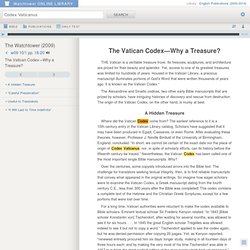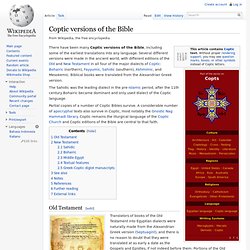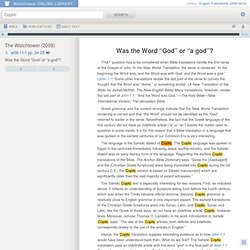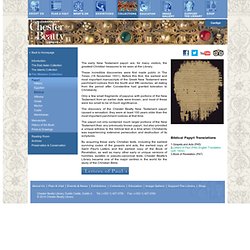

The Vatican Codex—Why a Treasure?—Watchtower ONLINE LIBRARY. The Vatican Codex—Why a Treasure?

THE Vatican is a veritable treasure trove. Its frescoes, sculptures, and architecture are prized for their beauty and splendor. Yet, access to one of its greatest treasures was limited for hundreds of years. Housed in the Vatican Library, a precious manuscript illuminates portions of God’s Word that were written thousands of years ago. It is known as the Vatican Codex The Alexandrine and Sinaitic codices, two other early Bible manuscripts that are prized by scholars, have intriguing histories of discovery and rescue from destruction. Where did the Vatican Codex come from? Over the centuries, some copyists introduced errors into the Bible text. For a long time, Vatican authorities were reluctant to make the codex available to Bible scholars. What kind of text did the Vatican Codex reveal? Two noteworthy scholars who were struck by the virtues of the Vatican Codex were B. Consider an example.
“It Will Last to Time Indefinite” Dating Ancient Manuscripts. Papyrus 66. Papyrus 66 (also referred to as 66) is a near complete codex of the Gospel of John, and part of the collection known as the Bodmer Papyri.

Description[edit] The first page of the papyrus, showing John 1:1-13 and the opening words of v.14 The manuscript contains John 1:1-6:11, 6:35b-14:26, 29-30; 15:2-26; 16:2-4, 6-7; 16:10-20:20, 22-23; 20:25-21:9, 12, 17. It is one of the oldest New Testament manuscripts known to exist, with its writing dated to around 200 CE.[1] In common with both the other surviving early papyri of John's Gospel; P45 (apparently), P75, and most New Testament uncials, Papyrus 66 does not include the pericope of the adulteress (7:53-8:11);[2] demonstrating the absence of this passage in all the surviving early witnesses of the Gospel of John.
Studies done by Karyn Berner[3] and Philip Comfort,[4] contended that 66 had the work of three individuals on it: The original, professional scribe, a thoroughgoing corrector and a minor corrector. Text[edit] History[edit] JOhn. The Coptic version of the New Testament in the Southern dialect : otherwise called Sahidic and Thebaic ; with critical apparatus, literal English translation, register of fragments and estimate of the version. The Coptic version of the New Testament in the Southern dialect : otherwise called Sahidic and Thebaic ; with critical apparatus, literal English translation, register of fragments and estimate of the version. The Coptic version of the New Testament in the Southern dialect : otherwise called Sahidic and Thebaic ; with critical apparatus, literal English translation, register of fragments and estimate of the version.
The Coptic version of the New Testament in the Southern dialect : otherwise called Sahidic and Thebaic ; with critical apparatus, literal English translation, register of fragments and estimate of the version. Coptic versions of the Bible. There have been many Coptic versions of the Bible, including some of the earliest translations into any language.

Several different versions were made in the ancient world, with different editions of the Old and New Testament in all four of the major dialects of Coptic: Bohairic (northern), Fayyumic, Sahidic (southern), Akhmimic, and Mesokemic. Biblical books were translated from the Alexandrian Greek version. Was the Word “God” or “a god”?—Watchtower ONLINE LIBRARY. Was the Word “God” or “a god”?

THAT question has to be considered when Bible translators handle the first verse of the Gospel of John. In the New World Translation, the verse is rendered: “In the beginning the Word was, and the Word was with God, and the Word was a god.” (John 1:1) Some other translations render the last part of the verse to convey the thought that the Word was “divine,” or something similar. The Western Papyri Biblical Collection, Chester Beatty Library Papyri Biblical Collection. The early New Testament papyri are, for many visitors, the greatest Christian treasures to be seen at the Library.

These incredible discoveries were first made public in The Times (19 November 1931). Before this find, the earliest and most important manuscripts of the Greek New Testament were parchment codices from the fourth and fifth centuries, all dating from the period after Constantine had granted toleration to Christianity. Only a few small fragments of papyrus with portions of the New Testament from an earlier date were known, and most of these were too small to be of much significance. The discovery of the Chester Beatty New Testament papyri caused a sensation; they were at least 100 years older than the most important parchment codices at that time.